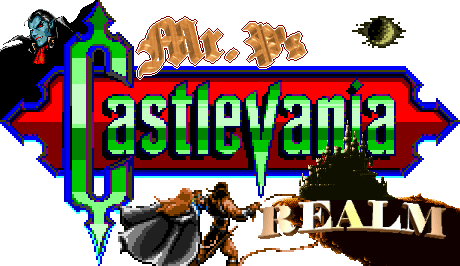
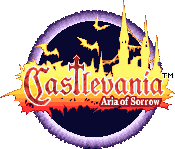
Unused Elements | Unused Items | Debug Menu
Essence of Chaos
People who have hacked into Aria of Sorrow's innards have found some interesting ways to manipulate the game's mechanics, as they once did with Symphony of the Night in creating methods to achieve over 200% castle completion. However, I always separate what Konami intended to be in the game from what was changed via a process of hacking. In the traditional sense, they did find one interesting thing.
This unused element was brought to our attention by Vcthug4life. In Symphony, you could escape from the game's two final battles using a library card, and you could do this for two reasons: To add Shaft and Dracula to your enemy list and to thus save the game onto the memory card with that final "room" to your credit.

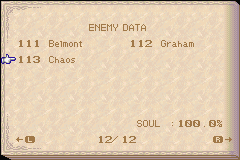
Konami had the same idea here but didn't follow through; it seems that the Chaos boss was to appear on your enemy list--but since the game doesn't save after its defeat, and since there's no way to escape from this battle, it would have been pointless to allow its inclusion on the list. Regardless, the page with the Chaos boss remains somewhere in that game pak, and it paints a unique picture of the foe.

The glitchy entry (highlighted by whatever it is that covers the creature's name) shows only a broad outline of the Chaos essence, wherein it's honing colorless crystals that resemble the projectiles it fires at a targeted Soma. Its description reads, "The root of all chaotic things," and it has no known weaknesses and a very large amount of HPs. Naturally, since the point is to rid yourself of its possession, there's nothing to learn and thus no experience to gain.
Konami Man and Konami Lady
![]()
Cart-inspector Soldjermon dug deep into Aria of Sorrow's array of tiles and discovered the mugshots of Konami Man, the company's official mascot, and his female companion, Konami Lady, who is of course Dr. Cinnamon's android creation. Neither makes an appearance in-game, as this is just another example of Konami sneaking its overlord mascots, somehow, into one of its creations.
|
|
|
Skull Key
|
Elsewhere on the game pak, stashed away, is the Skull Key, which you'll never collect during your adventure. Only by hacking into the game with a cheating device will you be able to add the item to your "Magical Items" list in the inventory. When on the list, its description reads, "Opens doors marked with a skull design," but there are no skull-marked doors in the game, which is a sign of an unfinished or an unrealized idea.
It's probably no coincidence that there is a Skull Key in Castlevania: Harmony of Dissonance (Aria's direct prequel, production-wise), which did have the job of opening skull-marked doors. So it seems that Koji's team was going to recycle this idea for Aria. However, they thought better of it and scrapped the whole plan, however insignificant it seems in retrospect.
The debug menu, often left unlinked within the contents of a game's files, is the developers' playground for testing the integrity of their game's programming. You can gain instant access to Aria of Sorrow's debug menu using a GameShark and the following code:
|
GameShark
Code:
|
5F1A6135 63794818 | |
| CCEC9F6E 5A2A0F12 |
After applying the code, use a soft reset to gain entry into the debug menu, which has eight available options. Not worth covering are "Start," which starts the game in its usual manner; "Trade," which takes you to the normal soul-trade screen; and "Staff Roll," which links directly to the credits sequence already accessible. I'll give a brief explanation of the five other options with screenshots where applicable.
Exit
Selecting "Exit" will take you to a screen with a list of seventeen locations--selecting any of which will allow you to start a game with a fully powered Soma. These locations include entrance points for eleven separate areas, the Boss Rush mode, and four boss-battle arenas.
1967
"1967" takes you to a sub-menu for one of the mode's oddly organized test areas. The sub-menu has four options:
|
|
|
|
| - | - | - |
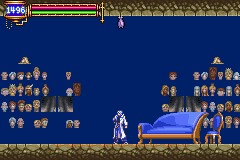 |
|
|
"ENEMY" allows you to take on any of the game's foes, boss and minor enemy alike, in the specially designated Boss Rush room--at least at first. You can avoid facing your chosen adversary, for now, and move to the adjacent rooms, where the same battle is waiting in other boss-room locations (one missing its background layer); there are three additional rooms to the left and eight to the right--the last of which, no matter the direction, is a prize-podium room, which has no reward; for whatever reason, the main tune ceases to play once you travel six rooms to the right, replaced by the sound of repeated thunder. As opposed to Juste Belmont's dire debug-menu predicament, Soma is more equipped to handle the tougher brutes thanks to an increased number of HPs, a Milican Sword, and a Buer soul.
"SDTEST" takes you to a gimped version of the game's Sound Mode, which is nothing more than a white screen with a missing text layer; your only means of navigating the screen is to push random buttons/directions and hope that it plays your favorite sound. More tangible is "START," which takes you directly to the end of Chaotic Realm, a magically infused doorway removed from the final boss. It starts you with a Soul Set of Axe Armor, Black Panther and Skula, and the equipment set Claimh Solais, Dracula's Tunic and Satan's Ring; your inventory is otherwise empty.
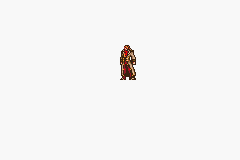
"OBJTEST" is a simple white screen featuring Juste Belmont's idle animation. It cannot be manipulated in any way.
2229
"2229" simply takes you to a Harpy-infested vertical chamber of the Clock Tower. Soma's abilities are most basic, and he has no access to his inventory, leaving little chance of survival.
2379
"2379" accesses another sub-menu--this one featuring three options and an exit function.
Selecting "BG" takes you into yet another sub-menu (a sub-sub-menu?) with three options of its own. "DISP" lets you view the decorative layers of the Castle Keep's Clock Tower background, which you can view by scrolling in any direction. "LINK TEST" drops you in an inescapable warp room in Soma-doll form; available actions include moving, jumping, and sprite-layer removal. "VRAM HIT TEST " positions you as an idle bat in the upper regions of the Castle Corridor; you can hover about in idle-bat form, but the screen will soon begin glitching--shaking more and more violently the further away you travel from the starting point--and eventually lead to the game crashing.
"OBJ" takes you to sub-menu with only a single option ("DISP TEST"), the selection of which flashes to another white screen displaying a single character--a simple bat that has no tricks to show us.
|
|
|
|
"ETC" has a two-option sub-menu. "S10 TEST 0" places Soma in the first room of the Castle Corridor, again with basic abilities and no inventory access; Soma's magic meter is missing, which means he can't even wish his way out of this inescapable room. "S10 TEST 2" displays a Japanese ASCII character that translates into "transmission"; selecting "START" accesses a GBA-link-connection test.
4531
"4531" shows the ROM revision and has available a list of seventeen different "events" up for experience. These events include boss battles, dialogue sequences, and the game's endings. Notable is that Soma's inventory is more populated than before, despite his still being too underpowered to complete certain tasks.
This information is credited to http://tcrf.net and was sent in by Christopher M.
|
[Home] [What's New?] [CV Library] [Stages] [Reviews] [Weapons] [Castleography] [Multimedia] [Codes] [Links] |
||||